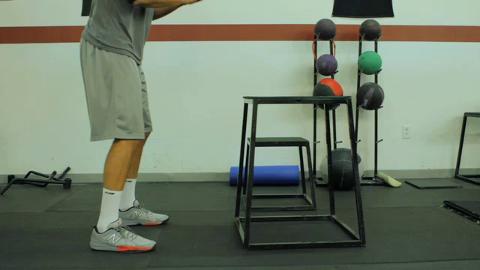
Coaching Cues to Make Your Strength and Conditioning Programs More Effective – Installment 12
It’s time to bring back this coaching cues series to the forefront, as it’s always been a popular one here at EricCressey.com. Here are three more cues I find myself using on a daily basis at Cressey Sports Performance:
1. “Chest before chin.”
One of the biggest issues we see in folks with a lack of anterior core control and/or upper body strength is that they’ll shoot into forward head posture as they descend to the bottom position of a push-up. Effectively, they’re substituting head/neck movement for true scapular protraction and retraction. One cue that seems to clean the issue up quite well is the “chest before chin” recommendation – which means that the chest should arrive at the floor before the chin does.
You do, however, need to make sure that the individual doesn’t confuse this with simply puffing the chest out, which would put them in more extended (arched back) posture at the lumbar spine.
2. “Get your scaps to your armpits.”
A huge goal of upper body corrective exercise program is to teach individuals how to differentiate between scapulothoracic movement and glenohumeral movement. In layman’s terms, this means understanding that it’s important to know when the shoulder blade is moving on the rib cage, as opposed to the upper arm (ball) moving on the shoulder blade (socket). Especially during overhead reaching, what we typically see in athletes is insufficient scapulothoracic movement and excessive glenohumeral movement – particularly in those athletes with noteworthy joint hyper mobility. This is one reason why we incorporate a lot of wall slide variations in our warm-ups.
Since we are really looking to teach good upward rotation (as opposed to just elevation), I always try to cue a rotational component to the scapular movement as the arms go overhead. I’ve found that “get your scaps to your armpits” can really get the message across, especially when this verbal cue is combined with the kinesthetic cue of me guiding the shoulder blades around the rib cage. These modifications can really help to kick up serratus anterior recruitment, as this video shows:
3. “Start in your jump rope position.”
When you’re working with young athletes on jumping variations – whether they’re broad jumps, box jumps, or some other variations – many of them will start with an excessively wide stance. Then, they’ll “dip” to create eccentric preloading (stretch) and the knees almost always cave in. As I’ve said before, if the feet are too wide, the knees have no place to go but in. My feeling is that many young athletes “default” to this pattern because a wider base of support generally supports a more stable position for a weaker athlete. Unfortunately, this position doesn’t put them in a great posture for producing force.
The best coaching cues are the ones that build upon those movements an individual already knows, and most kids have jumped rope in the past. If you use a wide stance when you jump rope, you trip over the rope. Instead, you have to stay with the feet in around hip-width, which is right where we want our jump variations to occur.
If you’re looking for more coaching tutorials and exercise demonstrations, be sure to check out Elite Training Mentorship, which is updated each month with new content from Cressey Sports Performance staff members.



